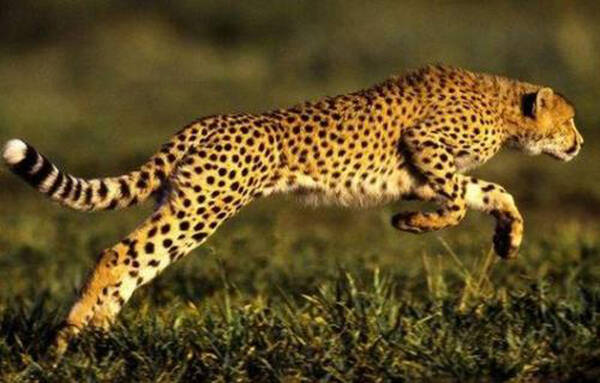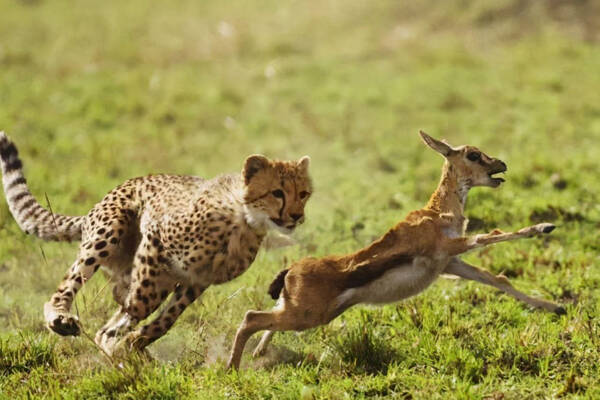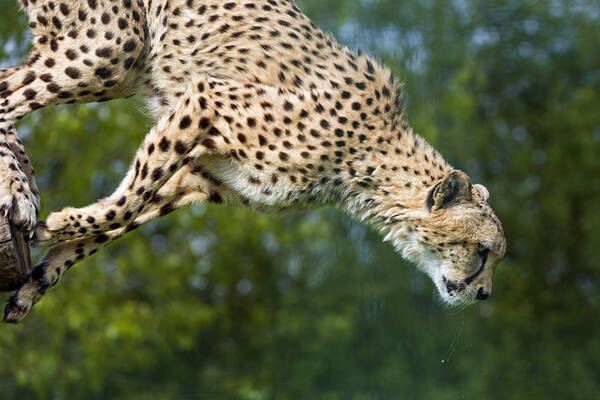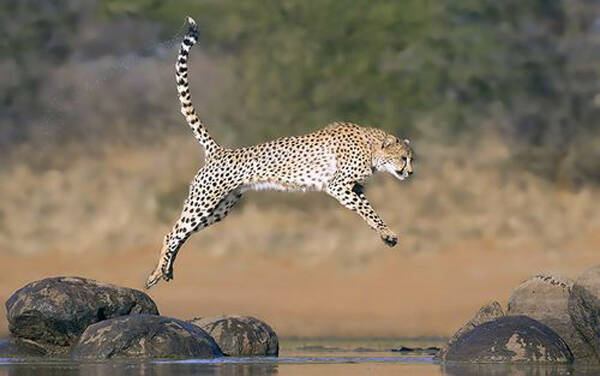Cheetah
IUCN
LCBasic Information
Feature
The fastest mammal on land (short distance) is the cheetah
Distribution and Habitat
Origin: Algeria, Angola, Benin, Botswana, Burkina Faso, Central Africa, Chad, Ethiopia, Iran, Kenya, Mali, Mozambique, Namibia, Niger, South Africa, South Sudan, Tanzania, Uganda, Zambia and Zimbabwe.
Suspected extinct: Eritrea.
Extinct: Afghanistan, Burundi, Cameroon, Democratic Republic of the Congo, Cote d'Ivoire, Ghana, Guinea, Guinea-Bissau, India, Iraq, Israel, Jordan, Kazakhstan, Kuwait, Malawi, Mauritania, Morocco, Nigeria, Pakistan, Rwanda, Saudi Arabia, Senegal, Sierra Leone, Syria, Tajikistan, Tunisia, Turkmenistan, Uzbekistan and Western Sahara.
Uncertain: Djibouti, Egypt, Libya, Somalia, Sudan and Togo.
Reintroduced: Eswatini.
In Africa, cheetahs are found in a variety of habitats and ecoregions, ranging from dry forests and dense scrub to grasslands and extremely arid deserts such as the Sahara. They are absent only in tropical and montane forests, although there are reports of cheetahs at elevations of 4,000 m on Mount Kenya. In Iran, cheetah habitat
Appearance
The cheetah has a body length of 110-150 cm, a tail length of 60-80 cm, and a shoulder height of 67-94 cm; it weighs 21-72 kg. The cheetah is a sexually dimorphic species, but it is difficult to determine the sex of a cheetah based on appearance alone. Male cheetahs are slightly larger than females and have larger heads, but they do not show the same degree of physical differences between the sexes as other big cats such as lions. The cheetah has a short and wide skull with a highly raised and arched forehead above the muzzle and skull. The nostrils are wide and enlarged, with bony plates extending well behind the molars. The nasal cavity is large compared to other cats to increase oxygen intake. The cheetah's lungs and heart are connected to a circulatory system with powerful arteries and adrenal glands that work together to circulate oxygen through the blood very efficiently. The cheetah's teeth are sharp, but they are relatively small compared to other big cats.
The che
Details
Cheetah (scientific name: Acinonyx jubatus) English Cheetah, Hunting Leopard, French Guépard, Spanish Chita, Guepardo, German Gepard, is the only species under the genus Cheetah, with 5 subspecies and 1 variant.

Cheetah population densities range from 1 per 20 square kilometers to 1 per 100 square kilometers. Some home ranges are reported to be between 50-130 square kilometers. Cheetahs can be solitary or live in small groups consisting of a mother and her cubs, several related adult males, or male and female siblings who have been separated from their mother recently when the female is not yet in estrus. Females adopt various movement patterns within their range, from single long-distance trips to staying in a general area for several days. Although the ranges of individual females overlap, they do not socialize. If females notice each other, they will sit 2 kilometers apart and observe the other until one eventually walks away. This behavior is also common in other female cats, with the exception of domestic cats and lions. Females do not defend their territory, although they do scent mark by urinating or defecating. However, the presence of cubs will change the female's movements depending on the age of the cubs.
Cheetahs live a relatively regular life, usually working from sunrise to sunset. Generally, they start to forage around 5 o'clock in the morning. They are more alert when walking, stopping from time to time to look around to see if there is any prey to hunt. Another point is that it also prevents other beasts from preying on them. It usually rests at noon. During the nap, it gets up every 6 minutes and checks to see if there is any danger around. Generally speaking, a cheetah only kills one prey at a time, and walks about five kilometers a day, or at most more than ten kilometers. Although it is good at running, it does not walk far.

The cheetah is the fastest animal on land in the world, and its speed can reach 115 kilometers per hour. If a human world champion sprinter and a cheetah were to compete in a 100-meter race, the cheetah would let the world champion run 60 meters first, and it would be the cheetah, not the sprinter, who would reach the finish line. Although cheetahs can reach amazing speeds, they cannot maintain high-speed pursuits for long periods of time. They must catch their prey in 30 seconds or less because they cannot maintain their maximum speed for long periods of time. Cheetahs spend most of their time sleeping, and their activity is the least during the hottest part of the day. They prefer shady areas and will sleep under the protection of the shade of large trees. Cheetahs do not hunt at night, they are most active in the morning and evening.
As female cheetah cubs reach sexual maturity, they will leave the group and live a largely independent life. Male brothers stay together for the rest of their lives, forming groups called coalitions. Coalitions increase hunting success and serve as a defense against other predators.
Cheetahs are different from other "big cats," a classification that includes: lions, tigers, leopards, and jaguars, who roar when they face danger. Cheetahs do not roar. The sound they make is more like a high-pitched chirp or bubble, and they bark when communicating with each other. Cheetahs also make purring sounds when they inhale and exhale. Although uncommon, vocal calls (described as "yipps" and "churrs") are made when members of a male coalition separate and continue for up to 20 minutes until they reunite with their mates. Females will also call to their cubs to locate them, especially if the cubs wander out of hidden dens.

Cheetahs are visual hunters. Unlike other big cats, cheetahs are diurnal, meaning they hunt in the early morning and evening. Cheetahs climb "game trees" or termite mounds to get the best vantage point to spot prey on the horizon. Hunting has several components. It includes prey detection, stalking, chasing, tripping (or capturing prey), and killing by throat suffocation. Cheetahs prey include: Thomson's gazelle, Gerd's gazelle, impala, young wildebeest, etc. When food is scarce, they will also attack zebras. In addition, ostriches are also frequently preyed by cheetahs. And other small and medium-sized antelopes, hares, birds and rodents. Cheetahs will also prey on cubs of larger groups of animals. Cheetahs generally prefer to prey on wild species and avoid hunting livestock. Exceptions occur in sick, injured, old or young and inexperienced cheetahs. Generally speaking, livestock preyed by cheetahs are also sick, injured and old/young. Keeping livestock in pastures and using non-lethal protection methods can greatly reduce livestock predation.
In nature, cheetahs are often defeated by some larger cats, such as lions, or they may be killed and eaten by lions. The survival rate of young leopards is very low, and two-thirds of them are killed by lions, hyenas, etc. or starve to death due to lack of food before they are one year old.
The cheetah life cycle is divided into three stages: cubs (birth to 18 months), adolescence (18 to 24 months) and adulthood (24 months and beyond). The gestation (pregnancy) period of a cheetah is 93 days, and the number of cubs per litter ranges from 1 or 2 to 6 cubs (occasionally there are records of 8 cubs, but they are rare). The mortality rate of cubs is higher in protected areas such as national parks and wildlife reserves, which are farther away from large predators than in non-protected areas. In these areas, the mortality rate of cheetah cubs can be as high as 90%. Male cheetahs generally compete for mates. It is not monogamous, it competes freely in the wild. The gestation period is 91 to 95 days, and a female cheetah can give birth to 1-6 cubs per litter, usually 2-4. Female cheetahs that give birth build their nests in places with dense grass, deep in the jungle, or in swamps, where other animals cannot reach, because there is a possibility that some beasts may prey on these little cheetahs.

Generally, cheetah cubs will start to hunt independently after they are one year old. The weight of a young cheetah is generally 240-300 grams. It will not crawl until 2-3 days after birth, and its eyes will not open until 4-14 days after birth. It will not start to eat until 21-28 days after birth, and it will start to be weaned after two months. After 9-10 months, female cheetahs begin to reach sexual maturity. Male cheetahs generally reach sexual maturity at 14 months old. When a young cheetah is born, it has some cloak-like hair on its back. The fluffy hair usually starts to fall off at two and a half months old. The lifespan of a cheetah in the wild is generally 15 years, but in captivity, a cheetah may live for 18 years.
There are only 9,000 to 12,000 cheetahs in Africa, and about 10% of them live in captivity. Protecting cheetahs has become a task for people, especially in Africa. In modern times, cheetahs are still regarded as a symbol of status. Although cheetah ownership and exotic pet ownership are banned in many countries, the demand for cheetahs as pets remains high. Cubs are illegally captured from the wild, and only one in six survives to find a potential buyer. The reasons for the decline in cheetah numbers are: the decline of herbivorous animals such as antelopes and wildebeests, which have reduced their range and reduced food resources; the isolation of cheetahs from human villages, roads and other human activities, which makes it very difficult for cheetahs to find mates; the third reason is the trade in cheetah skins, especially international trade. This trade has been restricted due to the implementation of the Convention on International Trade in Endangered Species, but this smuggling still exists, and these smugglers poach cheetahs, which is also a great threat to the survival of cheetahs.
Cheetah Day is celebrated on December 4th. In 2010, Dr. Laurie Marker designated December 4 as International Cheetah Day. The annual celebration honors a cheetah cub named Khayam, who she raised at a wildlife park in Winston, Oregon. Khayam was a cheetah who was trained for the first wildlife research project. The study was to determine if cheetahs born in captivity could be taught to hunt. In 1977, Dr. Marker took Khayam to Namibia for a research project. She witnessed how endangered cheetahs had become on that trip. Farmers were decimating cheetahs from the landscape as a way to protect livestock.
Listed in Appendices I, II and III of the Convention on International Trade in Endangered Species of Wild Fauna and Flora (CITES) 2019 Edition Appendix I.
Listed in the IUCN Red List of Threatened Species in 2014 ver3.1 - Vulnerable (VU).
Protect wild animals and eliminate game.
Maintaining ecological balance is everyone's responsibility!








